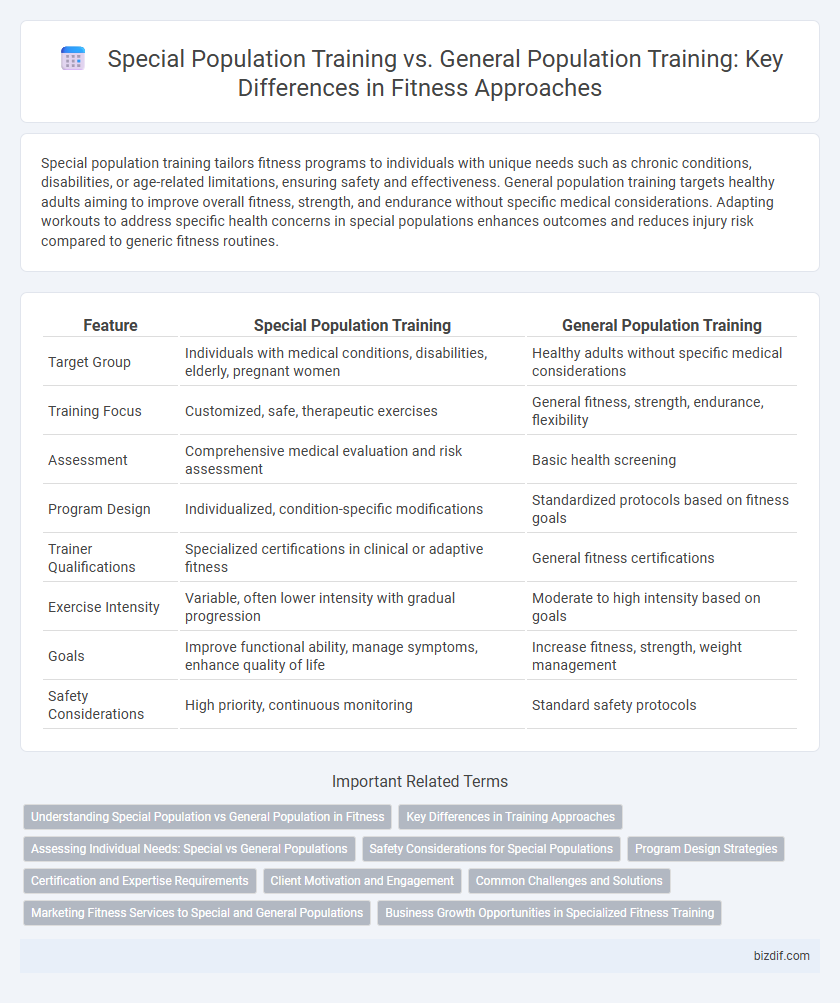Special population training tailors fitness programs to individuals with unique needs such as chronic conditions, disabilities, or age-related limitations, ensuring safety and effectiveness. General population training targets healthy adults aiming to improve overall fitness, strength, and endurance without specific medical considerations. Adapting workouts to address specific health concerns in special populations enhances outcomes and reduces injury risk compared to generic fitness routines.
Table of Comparison
| Feature | Special Population Training | General Population Training |
|---|---|---|
| Target Group | Individuals with medical conditions, disabilities, elderly, pregnant women | Healthy adults without specific medical considerations |
| Training Focus | Customized, safe, therapeutic exercises | General fitness, strength, endurance, flexibility |
| Assessment | Comprehensive medical evaluation and risk assessment | Basic health screening |
| Program Design | Individualized, condition-specific modifications | Standardized protocols based on fitness goals |
| Trainer Qualifications | Specialized certifications in clinical or adaptive fitness | General fitness certifications |
| Exercise Intensity | Variable, often lower intensity with gradual progression | Moderate to high intensity based on goals |
| Goals | Improve functional ability, manage symptoms, enhance quality of life | Increase fitness, strength, weight management |
| Safety Considerations | High priority, continuous monitoring | Standard safety protocols |
Understanding Special Population vs General Population in Fitness
Special population training targets individuals with specific needs such as chronic diseases, disabilities, or age-related conditions, requiring tailored exercise programs to ensure safety and effectiveness. General population training focuses on healthy individuals with standard fitness goals, emphasizing overall strength, endurance, and flexibility. Understanding these distinctions enables fitness professionals to design customized plans that optimize health outcomes and minimize injury risks.
Key Differences in Training Approaches
Special population training emphasizes individualized assessment, focusing on medical history, mobility limitations, and chronic conditions to tailor safe and effective exercise programs. General population training typically targets broader fitness goals such as strength, endurance, and weight management using standardized protocols. Adaptations in intensity, exercise selection, and progression are critical in special population training to mitigate risks and accommodate unique physiological needs.
Assessing Individual Needs: Special vs General Populations
Assessing individual needs in special population training requires a comprehensive evaluation of medical history, physical limitations, and specific health conditions to customize safe and effective exercise programs. In contrast, general population training primarily focuses on fitness goals, performance improvement, and injury prevention without extensive medical considerations. Tailoring assessments to these distinct requirements ensures optimal training outcomes and minimizes health risks for both groups.
Safety Considerations for Special Populations
Special Population Training requires tailored safety protocols, emphasizing careful assessment of chronic conditions such as cardiovascular disease, diabetes, and mobility impairments to prevent injury and adverse events. Unlike General Population Training, it prioritizes low-impact exercises, individualized progressions, and continuous monitoring to accommodate physical limitations and medication effects. Ensuring proper supervision by certified professionals specialized in medical exercise physiology enhances safety and effectiveness for special populations.
Program Design Strategies
Special Population Training requires tailored program design strategies that address specific medical conditions, mobility limitations, and individual risk factors, ensuring safety and effectiveness. General Population Training emphasizes broader fitness goals with standardized protocols focusing on strength, endurance, and flexibility for healthy individuals. Customization of exercise intensity, progression, and recovery protocols distinguishes special populations from general training approaches to optimize outcomes.
Certification and Expertise Requirements
Special Population Training requires advanced certifications such as the NASM Certified Special Population Specialist (CSPS) or ACSM Certified Exercise Physiologist to address unique health conditions and physical limitations safely. General Population Training typically demands a foundational certification like NASM Certified Personal Trainer (CPT) or ACE Certified Personal Trainer, focusing on broader fitness goals without specialized medical considerations. Expertise in anatomy, physiology, and risk management is crucial for Special Population Training to customize programs effectively and ensure client safety.
Client Motivation and Engagement
Special Population Training requires tailored motivational strategies to address unique physical, psychological, and medical needs, enhancing client engagement through personalized goal-setting and adaptive exercises. In contrast, General Population Training often relies on standardized motivation techniques such as group classes and performance tracking to maintain engagement. Understanding client-specific drivers boosts adherence and optimizes fitness outcomes across both training modalities.
Common Challenges and Solutions
Special Population Training often involves clients with medical conditions, disabilities, or age-related limitations that require tailored exercise modifications, while General Population Training typically addresses a broader audience with standard fitness goals. Common challenges in Special Population Training include managing chronic diseases like diabetes or heart conditions, adapting workouts for mobility impairments, and ensuring safety through careful monitoring of vital signs. Solutions involve individualized program design based on thorough assessments, interdisciplinary collaboration with healthcare providers, and implementing adaptive equipment or low-impact exercises to enhance accessibility and effectiveness.
Marketing Fitness Services to Special and General Populations
Marketing fitness services to special populations requires tailored communication that highlights accessibility, safety, and customized programming for clients with unique health conditions or limitations. In contrast, general population training appeals to a broader audience by emphasizing overall wellness, performance enhancement, and convenience in service offerings. Effective marketing strategies differentiate these segments through targeted messaging that addresses specific needs and motivations, increasing client engagement and retention.
Business Growth Opportunities in Specialized Fitness Training
Special population training targets unique groups such as seniors, pregnant women, or individuals with chronic conditions, providing tailored programs that address specific health needs and limitations, creating higher client retention and satisfaction rates. Businesses specializing in this niche leverage expertise in medical fitness, rehabilitation, and adaptive workouts, gaining competitive advantage and access to underserved markets. This strategic focus enables fitness centers to diversify revenue streams, commanding premium pricing and fostering partnerships with healthcare providers.
Special Population Training vs General Population Training Infographic

 bizdif.com
bizdif.com